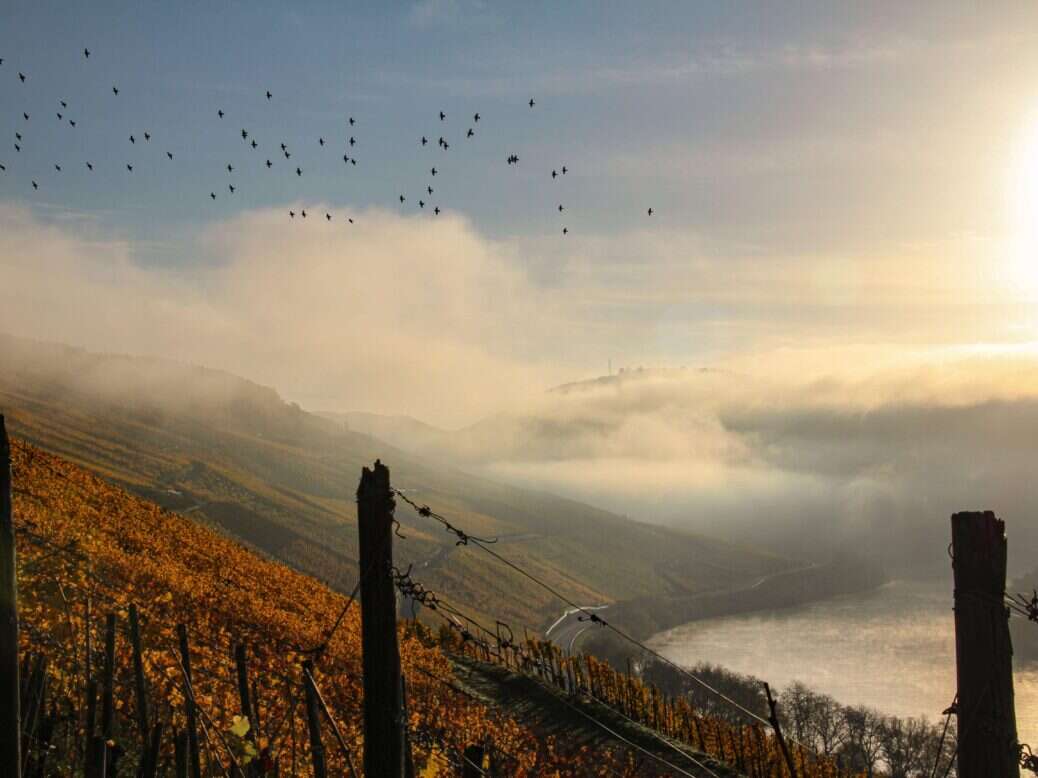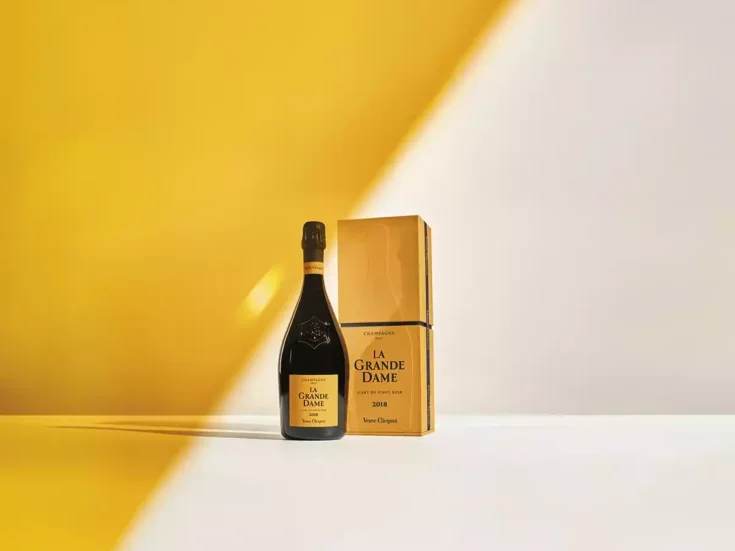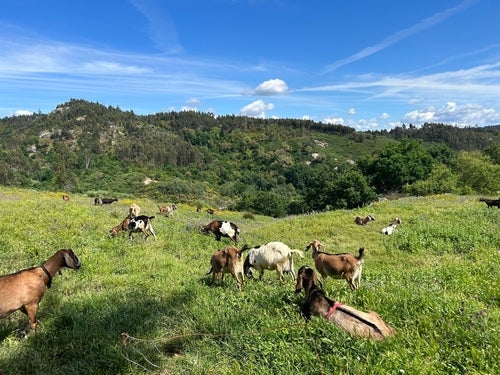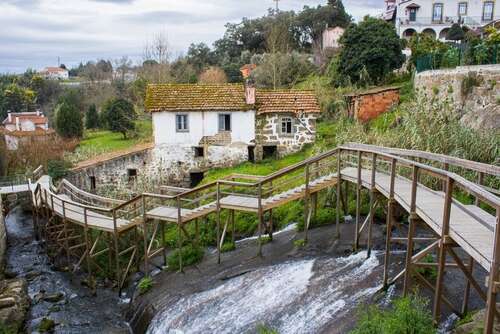
Terry Theise goes on a virtual pilgrimage to Schloss Lieser, delving deep into the Mosel estate’s latest entrancing releases.
The estate came to us—“us” because I was still with Skurnik—in the waning days of Rudi Wiest’s business, and because the estate has such a stellar reputation we broke protocol and began to represent them before having a chance to taste (systematically) or visit. I carved out a whole half-day to see them in March, 2020, but, well, you know.
I’m touched that they sent samples. I very much plan to visit them as soon as it makes sense. But right now, I’m in the position of tasting in depth an estate of which I have no first-hand knowledge. That’s unusual for me, but it’s also a hurdle I can easily clear.
However, it does compel a choice. We did a zoom meeting just to fill in some background information and to confirm a few impressions I’d formed. Having done that, I still arrive as a pilgrim to this estate, and it’s a feeling I like. It creates an alertness I enjoyed as a beginner, as I filled in each picture piece by piece.
There’s something to be said for tasting tabula rasa. I did taste them that way, but as I write, none of the bottles are empty yet. I’ll end up with a hybrid approach, but I am disinclined to squander the unmitigated view of those wines. Intuitively it feels pure, and it reflects the great purity of the wines themselves. About which more later.
Schloss Lieser: Flights in the cause of beauty
Though I list the wines in order of dry to sweet, I didn’t taste them that way. The estate sent 24 wines, and while I “could” taste two dozen wines in one sitting—I often tasted up to 100 wines over a tasting-day at Selbach—why did I need to? It seemed both masochistic to insist upon it, as well as injurious to the cause of beauty. I don’t think machismo has a place in the tasting room. I can taste more wines than you can, stud! Okay, that must be very nice for you.
What I did instead is divide the wines into flights, with each flight going from dry to sweet, and I tasted them over 2-3 days. That also avoided the need to taste all the sweet wines—Spätlesen and Auslesen—in a single chunk. I’ve learned my palate doesn’t like to do that. By the end of the sequence I’ve had a surfeit of sucrose, and a low level of crankiness makes it into the notes, and even if I can avoid that, it is ungrateful.
Stemware was simple, a trio of my “control” glass (the Spiegelau white wine 1.0) along with the MacNeil Crisp & Fresh and finally the Jancis. Finally, today began a seam of perfect early Fall weather, ideal for tasting, especially for tasting outside as I most prefer to do.
A final note as to style: The estate is in principle an ambient-fermenter working in stainless steel. Thomas Haag feels that today’s ripe vintages don’t need the mellowing of Fuders, preferring to use steel to bring about the focus and refinement he seeks. The results are delicate, focused, articulate.
The wines of Schloss Lieser
2020 Weissburgunder Trocken
This should be interesting. I spent the previous week immersed in Weissburgunder from Dautel and Ziereisen, and along comes this brute from the frozen north of the Mosel with 13% alc.
It smells beautiful, but what does it smell like, Pinot Blanc or Mosel wine?? It is very different from Selbach’s, less vinous and less umami-driven, but correspondingly more brilliant and chiseled. As a rule Mosel growers will make such a wine to offer their customers an everyday dry wine that’s more neutral and less pointed than Riesling, but this wine is anything but neutral, and considering its alcoholic heft it is markedly focused and light-footed.
In other words, don’t approach it looking for a bland dry white to wash down your fish. It has too much personality! It carries a northern gleam and iridescence without specific slate.
2020 SL Riesling Trocken
Obviously, the basic estate dry. It hails mostly from Kesten and Lieser, along with early pickings or young vines from other sites; the general pattern is consistent, with small specific variations from year to year.
It is scented finely, with some echoes of sponti but not full-on Mosel madness. Lots of smokiness and character. (This Mosel smoke shown by many 2020s is a kind of jab from the underlying Urgestein in certain sites, and is often obscured by body and glycerin in other vintages.) In most ways this is just what it “should be” and in one way it is happily surprising; a hint of white nectarine and ripe greengage plum wisping around the core of slatey energy.
The MacNeil does the wine no favors, curiously. It’s raspier and more phenolic than in my reliable little Spiegelau, and the refined nectarine becomes a less refined apricot. The wine is smart and craftsmanlike and prefers a neutral glass to a hedonic one. The Jancis totally rawks it, thus prompting a nascent hypothesis; wines as elegantly formed as these are will shine in a glass that showcases their clarity. Or clarities. The piddling few grams of RS I suspect (approvingly) are in the wine, are only discernible in this glass.
With re-tastings the supremacy of the Jancis was even more apparent. If I were Thomas Haag I’d buy ten dozen of these stems to have in his tasting room. Even this “little” wine is revealed with clarity and dialogue from that glass.
Time is kind to the wine; after three days the texture grew broader and the wine felt less constricted.
2020 Kabinettstück Riesling Trocken +
Still an estate-wine, the back label suggests a finer choice of vineyards
More sponti. Also more backward, and also much more structure and minerality. If the above is satisfying, this wine is exciting. It’s a first cousin to Dönnhoff’s Tonschiefer, and it’s quite a Mosel portrait, with the oolong and jade and balsam and smoke and pear, all the cool elements and the insinuations of flowers and apple-cellars. A wholly admirable and delightful beauty.
And it bears mentioning that such a triumph would have been virtually unthinkable along the Mosel 20 years ago. Maybe even 15. It’s one thing to baby your best material into a “GG” but it’s quite another to craft such a wonder as this—with its 11.5% alc—at the basic level. Whether it’s climate change, know-how, sense-memory or frame of reference, the Mosel is establishing an improbable track record for good to superb dry Rieslings.
Words I thought I’d never say.
2018 Kabinettstück Riesling Trocken
I’m not sure whether they sent this because it’s on the (American) market right now, or because they wanted to give me a little perspective courtesy of a back vintage. I’m happy either way!
But it’s fascinating to compare the relative rowdiness of this hot-vintage wine to the silvery lunar coolness of the ‘20s. It has its toddler fruit now, with a fetching and suave fragrance, and even a little alcoholic heat on the finish. (I’ll bet the feinherb was fantastic in this vintage.)
I won’t obsess over this modestly tiered wine. It does the job perfectly well. But I have to wonder whether the fruit will develop its more vinous notes before the finish is overcome by that chile-pepper heat. Personally I wouldn’t risk it beyond another year, and with that said, I’d be perfectly glad to drink it now. The fragrance is certainly fetching on the second day, though the finish is still exposed and bristly.
I’m in a state of expectation with many of the 2018s. Some aren’t attractive now, but that’s neither here nor there. The question is whether the wines are in a hot-vintage trough, from which they may well emerge as the best of the 2003s did, or whether their current tantrums signal the beginning of the end. There’s also an ancillary question: Was this vintage more kind to Fuder than to steel? Any trough they may be in would be even more stark in the pitiless environment of the steel tank.
2020 Riesling Heldenstück Trocken +

The village-wine, from the best steep slopes of Lieser, including the fruit of ancient ungrafted vines.
I won’t point out sponti any more, unless it is surprisingly absent or especially blatant.
Years ago I’d drive through Lieser (typically with Hans and Sigrid Selbach) on the way to an appointment somewhere else, and we’d often observe—forgetting that we made the same observation every previous year—that Lieser had great vineyards and was only awaiting a champion who would give voice to them. Thomas Haag’s story has long since been told, and celebrated, but I am old enough to remember when that land’s potential was sealed away, and now I can feel a special flush of thankfulness to see it liberated.
This wine is Serious Business, with much greater density of both flavor and texture. Markedly mineral and fibrous (apple-skins), it shows a command and an adamance that isn’t at all brusque, but simply doesn’t care to ingratiate.
Forgive my beginner’s fumblings. I’ve had some really earnest Graacher Himmelreich with this particular almost rice-like density, and even more improbably I find a kinship between this and Forster Jesuitengarten, though the latter wouldn’t show such blatant mineral. There’s a savory sort of warmth that will be a signature for these Lieserers.
It’s like a single note that reverberates with a dozen overtones. It’s implosive. It pulls you inside. It’s passionately introverted. It has everything Riesling can show without “fruit.” What a wine to teach with! “Think Riesling is a fruity wine? Think again, Ace.” A wine like this is a Doctoral thesis in minerality in almost bottomless detail.
2020 Riesling Goldstück Trocken
This is the village-level wine from Piesport. The sponti note is especially pronounced here, to a point some may find objectionable. The wine shows the broadness and geniality of Piesporters, without the verve and wit of the Lieserers. It’s very good—needless to say—in its mellow way; nor is there a law saying that all Rieslings need to be jittery and mineral. I can see times when an undemanding Riesling like this would be just the ticket.
But there is mineral here, and a lot of saltiness, and both of them set up camp on the back-palate, resting comfortably, one could say. And I freely admit I’m a little cool toward the Piesport type. I prefer more of a spinal column in my Mosels, but if I take that preference into account, I must admire the achievement this wine embodies. It isn’t easy to make interesting wine from most of these sites, and the estate has done it without forcing the wine into a nervy dialect it doesn’t speak naturally.
So what we have is a dramatic minerality allied to a horizontal structure, as opposed to Riesling’s usual verticality. It’s Mosel in Romanesque form. It will be somebody’s favorite wine because it doesn’t jab.
On day-2 a sourness entered the back palate and finish. It could be me, but again, I can only report faithfully. Growers have told me that sourness can be linked to sulfur, and we know that fruit can withdraw for a few months after bottling.
2019 Kabinettstück Riesling Trocken
A full percent higher alcohol than the ’20.
A very different wine now, and almost as good as the 2020. Almost!
Due to both the pandemic and to “changes” in my professional circumstances, I didn’t get to survey the 2019s in breadth or depth. I’m sensing that getting to them only now means I see them retreating from their baby-charm. I’m also clear that ’20 is much more my kind of vintage—but I’d probably have been pretty stoked by ‘19s if I’d tasted them, as I used to do, in March of the following year.
I like this wine a lot. ‘19s are golden and welcoming, while ‘20s are silvery and diffident. But the qualities of flavor in the ‘20s are piquant and haunting. You tingle as though you’re talking with a ghost. The ‘19s are more like rolling around in the grass with your ecstatic dog. And hey, there’s nothin’ wrong with lip-smacking wines, generosity is a good thing, and ’19 seems to have vertebrae beneath its overt ripeness. It’s an intelligently extroverted vintage, apparently. ’19 glows, and ’20 shimmers.
When this wine emerges from its disequilibrium I’d anticipate an elegant and minerally Riesling, with a tasty magnetism. I’ll be off in some quiet corner with my bottle of ’20, steeping in my unfathomable perversity.
2019 Niederberg Helden Riesling GG ++
(full name, Lieser Niederberg Helden Riesling Trocken)
Contiguous vintages don’t always play nice together. Sometimes the new baby-wines flatter the yearling, and other times….they don’t. I begin to sense that ’20 is essentially unkind to ‘19s if you taste them together. And there is also the question of the phase the ‘19s might be in.
But with all that said… what a superb Mosel Riesling aroma!
The site seems to show a special piquancy, reminding me of Wintricher Ohligsberg. It is angular rather than enveloping, serpentine rather than straight. This is a thoroughly beautiful wine, with which my own relationship has its angles. Of course I am duly impressed; how could I not be? (How could anyone not be??) I’m struck by the wonderful dispersed floweriness (if it were Austrian we’d be talking about “meadow-flowers” and goldenrod), the sweet-corn savoriness, the Dragonwell bite (non-tea lovers will have to take my word for it) and the blissy dream of fragrance that hovers above gravity, between sweet and savory, fruit and flesh. I’m not saying this in order to spring a rhetorical trap; I bow before this wine, which is almost a masterpiece.
Yet the first taste left me wanting, impressed but not completely fulfilled. I’m sure this is a minority opinion—in fact I may be a minority of one! But—I wanted it to be less dry. “GG” has an upward limit that didn’t suit this outstanding wine. It would still have tasted dry with 12-13 g/l of residual sugar (as opposed to the 9g max for GG) and it would have been exponentially better, more thrilling, more multi-faceted, more complex, more gorgeous, not to mention adding 15-20 years to its life, and removing the asperity from the finish.
At the table the wine felt more whole, and over the days I started to suspect I was being churlish. The wine is superb! And yet….
It is the problem with most strictures and rules based on bloodless analytical figures. I get that the “buyer-of-GG” is entitled to the presumption of dryness, and I get that “dryness” needs to be measured somehow (or does it?), but then you’ve created a round hole that’s inimical to the shapes of (however-many) square wines. I just want wines to be as great as they can be, and I think 90% of all the wine-rules on earth could be flushed down the toilet, to the great relief of drinkers everywhere. A little surprise won’t hurt you! But predictability will suffocate you.
Sermon concluded! The wine is splendid. Don’t bother with weird old me, and my strong sense that a few more grams of RS would have catapulted this wine to the outer galaxies.
Click here for the second part of Terry Theise’s report on Schloss Lieser.
A note on scores by Terry Theise
I disapprove of points. I don’t recognize measuring wines against a notion of “perfection,” I think it’s a fool’s errand to assign absolute value to an ephemeral impression, and the more precise a scoring system purports to be, the more it actually misleads.
That said, my mind forms hierarchies of its own volition, and special wines warrant special attention. So I’ll revert to my deliberately inexact system of plusses—one, two, or three—to recognize the most remarkable wines. My plusses are sort of like Michelin stars. One plus is a wine that stood out. Two plusses is a wine that made me stop and consider the depth of its beauty. Three plusses is a wine that tingles with greatness, and offers a moment of profundity. Feel free to superimpose whatever scoring system you deploy; the point-systems are harmful but the folks who use them aren’t evil, so if you want to conflate my three plusses with a scoring range that makes sense to you, be my guest.
Extracted with permission from Terry Theise’s Tasting Protocols.






